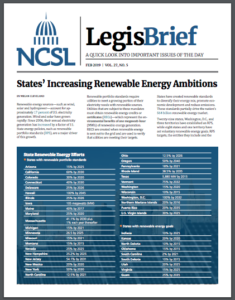Full Title: STATES' RENEWABLE ENERGY AMBITIONS
Author(s): MEGAN CLEVELAND
Publisher(s): National Conference of State Legislatures
Publication Date: February 1, 2019
Full Text: Download Resource
Description (excerpt):
Renewable energy sources—such as wind, solar and hydropower—account for approximately 17 percent of U.S. electricity generation. Wind and solar have grown rapidly: Since 2006, their annual electricity generation has increased by a factor of 11. State energy policies, such as renewable portfolio standards (RPS), are a major driver of this growth.
Renewable portfolio standards require utilities to meet a growing portion of their electricity needs with renewable sources. Utilities that are subject to these mandates must obtain renewable energy credits or certificates (RECs)—which represent the environmental benefits of one megawatt-hour (MWh) of renewable energy generation. RECS are created when renewable energy is sent out to the grid and are used to verify that utilities are meeting their targets.
States have created renewable standards to diversify their energy mix, promote economic development and reduce emissions. These standards partially drive the nation’s $64 billion renewable energy market.”
